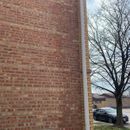Wet exterior bricks,
Hello,
For two years now, my top floor tenants have been experiencing mold at corners of outer wall in the west and east exposure in the spring.
We had our roof replaced 5 years ago.
Prier to that we never had a problem.
The roofer states it is nothing wrong with roof.
We had a second roofer same answer nothing wrong.
I have noticed that the EXTERIOR WALL where down spout is , IS wet.
WE are in Chicago.
We had a-lot of Ice on gutters this year. But not last year.
Do you think that Insulation or Flashing is the problem??
Gutters both roofer said are ok.
any advise?









Replies
rikos,
I lived in the Chicago area for 35 years and gutters were the bane of my home chores. Your picture shows a tree in the distance, so I can't tell if you are picking up leaf litter into the gutters from trees not in the picture. I can tell you that locust trees are the worst for clogging gutter downspouts. The next worst are the idiot birds. I regularly removed nests that were built directly over the downspout holes. Why this was a favored spot escapes me. They did manage to move a great mass of string, twigs and whatnot while nesting, half of which of course fell down the spout where it got stuck in the second turn of the path to the vertical drop that is anchored to the house cladding. The rain water would back up and flood out the joints to wash down the wall. This behavior fits what I see in the picture. Check the elbows as a first step. Check the whole drop and bottom elbows or connections to ground pipes next in case the whole length of the down drop is stack loading and weeping out the seams.
The wetting of walls inside on the second floor sound much more like a possible flashing or insulation issue. Or possibly the lack of a ice and water sheet for at least the first 3' up the roof. Did the roofers mess with the gutters during the re-roof? Did you have a separate gutter company do new gutters after the roof work? Or new fascia trim?
Flashing and trim problems are unfortunately common. Below is a link that will help you better understand the differences in drip edges, another problem area.
https://www.iko.com/na/pro/building-professional-tools/learn-about-roofing/guide-to-drip-edges-for-shingle-roofs/
I prefer the D style which supports the shingles better and results in a longer drip edge that helps to reduce if not eliminate any backward movement of water. The basic 90 fold can work, but the extended shingle edges are more prone to cracking or drooping over time. Neither form of drip edge will help you if the gutters are full of ice and the downspout ells are clogged. How the gutter hangers are applied can be another issue. If you had new aluminum fascia trim applied with the gutters there are more things to check on.
在极端结冰条件下大雨紧随其后s, it is possible for the water to rise in the gutter enough to back flow behind even a properly hung gutter. Hanger screws can provide a path for water to get behind the drip edge and if really badly done all the way behind the fascia board/trim. The water will then track the fascia board or aluminum cover trim. If the fascia board/trim is not also set to act as a drip edge or the trim fold is a simple 90 degree to cover fascia and soffit in one go, the water will follow along the soffit face or even behind the soffit material and then into and down the brick. Martin may weigh in with a better description.
The fact that you did not have problems for the years before the roofing was done over does kinda point to someone missing a detail that is now showing up thanks to the crazy weather Chicago has been having recently. Ice dams are still fundamentally caused by heat loss from living spaces into the attic. If you have not also been doing insulation work in the same time frame as re-roofing then it seems that Chicago weather would have dished up similar conditions before the re-roof.
Most of the wetness being at the downspout location points to a clogged drain path over mis-applied trim or gutters. Still, don't ignore inspecting the whole eave length.
If the birds from hell are indeed building nests over the downspout holes, I would recommend a drain guard that is a long slotted wedge shape I found at Menards. The wire basket type were easily knocked aside and didn't handle locust leaves at all well. Gutter covers are highly variable in how much they will readily shed leaves, especially wet leaves. If you have deciduous trees that shed onto to the roof, then clean the gutters AND the downspout elbows every fall without fail. No fun on a two story.
Thank you Roget.
No we did not have gutters done at the time we did roof.
But we did have new down spouts installed.
We installed the wider ones before issue began.
I will check all that you suggested.
Thank you.
Rikos.